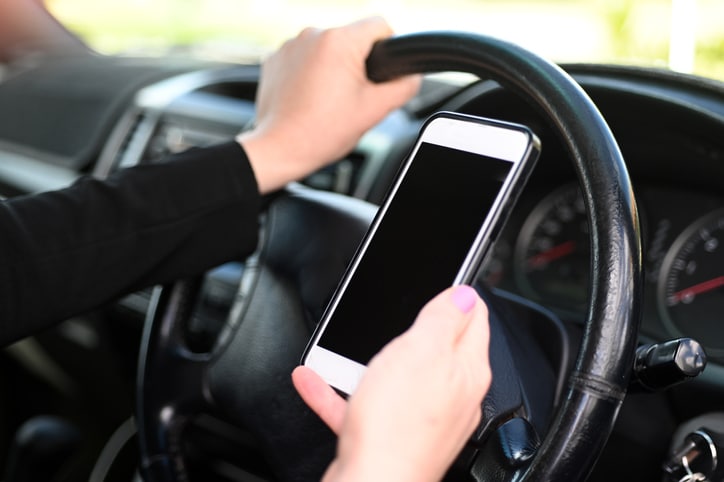Mobile device detection cameras will be introduced in the ACT in the second half of 2021 to target driver distraction and improve road safety.
The ACT Government has funded this initiative as part of their commitment to Vision Zero – no deaths or serious injuries on our roads.
Driver distraction was a major safety issue on ACT roads, Minister for Transport and City Services Chris Steel said.
Drivers who looked at their mobile phone were three times more likely to be involved in a crash, while those who texted and looked at emails on their mobile phone increased their crash risk tenfold.
Mobile phone cameras in other states have reduced illegal mobile device use while driving, Mr Steel said; in NSW, for instance, it decreased by 80%.
How will the cameras work?
New cameras will use artificial intelligence technology to detect whether a driver is using a mobile device. A sensor system detects and records the presence of all vehicles, and a specialised camera system captures high‑resolution evidence of device use.
The cameras follow strict privacy requirements, Mr Steel said.
- Images of front seat passengers are pixelated, and the cameras must not see into the rest of the car
- All images captured by the cameras that do not indicate mobile devices are rapidly and permanently deleted within seconds. More than 95% of images are ruled out by AI image analysis, and is never viewed by a person. Only when a camera detects device use does an authorised person confirm it.
- Only the minimum amount of data required to detect and enforce offences is retained
- Defined use and disclosure of images captured by the cameras
- Obligations for the secure protection and encryption of the images.
The cameras can operate 24 hours a day in all weather conditions and at all vehicle speeds.
Reducing dangerous driving
Road safety cameras used in conjunction with police enforcement will be critical in addressing high-risk behaviours on our roads, Mr Steel said.
ACT drivers continue to use their mobile devices while driving, he said; 1,008 infringement notices and 190 cautions were issued in the Territory in 2020. Evidence suggests that significantly more ACT drivers use their mobile devices illegally.
“Further steps are needed to reduce this behaviour,” Mr Steel said. “With the rollout of this new technology, we hope that we see less people driving whilst distracted, so that serious crashes can be avoided.”
He expected the number of drivers detected using their mobile device illegally in the ACT to decrease as the community adapted to the presence of cameras.
“This is a significant change in technology, and we will give the community a period of time to adapt to the operation of the mobile cameras.”
The ACT Government will conduct an extensive campaign to educate the community on the operation of the cameras and the risks associated with mobile device use. There will be a three-month no-fine warning period when the cameras are first deployed. During this time, warning letters will be sent to infringing drivers without penalty.
What are the penalties for dangerous driving?
Drivers who use their hand-held mobile device to make or receive a call can incur a maximum court fine of 20 penalty units or an infringement notice penalty of $480 and 3 demerit points.
The current penalty in the ACT for a driver who uses a mobile device for messaging, social networking, mobile application or accessing the internet is a maximum court fine of 20 penalty units or an infringement notice penalty of $589 and 4 demerit points.
The penalties for mobile device use will be the same regardless of whether the offence is captured by a camera or the police.
“The penalties are significant and reflect the risk that driver distraction poses to the community,” Mr Steel said.
“Every accident that results in serious injury or death is a tragedy and costs the community in some way; including through heartache to family and friends, loss in productivity to our city’s economy and increased pressure on our health system.”
Can I use a phone while driving?
Under the Road Transport (Road Rules) Regulation 2017, it is illegal for a driver to use a mobile device while the vehicle is moving or is stationary but not parked. (Exemptions apply for emergency or police vehicles.) Parking includes stopping and allowing the vehicle to stay (whether or not the engine is running).
A mobile device in the ACT includes a mobile phone and any other wireless hand-held or wearable device designed or capable or being used for telecommunications (for example, a tablet or smartwatch), but does not include a citizens band (CB) radio or any other two-way radio.
Drivers can use their mobile device for GPS purposes; to stream, play or listen to music or audio files; or to make or receive audio calls if the device is secured in a mounting affixed to the vehicle, or if the driver does not press or manipulate the device (e.g. through Bluetooth).
Learner and provisional car and motorcycle licence holders cannot use mobile devices while driving. The ban includes using the phone hands-free, in speaker mode, or through voice activation. Exceptions are provided for GPS and streaming music; for example, where the device is not held by the driver and the device is programmed before the trip starts so that it does not require any interaction during travel, including by voice.
For more news:



